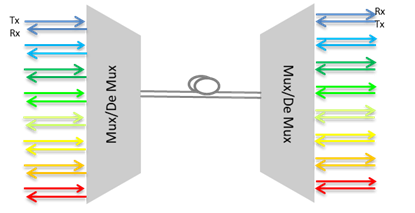Anyone who has been stuck in congested traffic has felt the pain of too many cars condensed into a finite number of lanes. Adding more lanes to highways can alleviate traffic congestion and ease bottlenecks, but it comes with a hefty price in terms of both dollars spent and commuter headaches. Luckily, solving your network bottlenecks doesn’t need to be this difficult.
Transceiver-based solutions can ‘add more lanes’ to your network while avoiding the cost of expensive switch and network upgrades. Single-Fiber Bidirectional, CWDM, and DWDM transceivers are all compatible with existing network switches and, when used with passive networking, they truly can fix your network bottlenecks – without the headaches.
Single-Fiber Bidirectional Transceivers (commonly known as BiDis') are the most simple and cost-effective solution. BiDis essentially add another lane of capacity onto an existing single-mode fiber pair. BiDi's send and receive signals over one single fiber strand as opposed to using both fibers of a traditional transceiver pair. This solution provides welcome relief in all network segments, particularly lending itself well to providing relief in campus environments and access networks.
Traditional Transceiver Alignment

Single Fiber BiDirectional Alignment

Wavelength Division Multiplexing (WDM) offers cost-effective scalability in maximizing existing fiber infrastructure. WDM uses passive multiplexers and transceivers to quickly scale the capacity of existing optical fiber infrastructure. WDM technology segments the fiber cable by transmitting the data on different wavelengths for each connection.
WDM comes in two kinds: CWDM and DWDM. Standard Course Wavelength Division Multiplexing (CWDM) is the most cost-effect technology, offering 18 connections over a fiber pair (that is 18 lanes in each direction). New single-fiber, single wavelength CWDM transceivers work with existing fiber and WDM infrastructure to push CWDM’s density up to 18 connections over a single fiber! Dense Wavelength Division Multiplexing (DWDM) are ideal for longer distances and raise the bar for fiber density. With DWDM, transceivers and passive multiplexers can push over 80 connections on a fiber pair.

Comparing Technologies
Raymond Hagen
Americas Product Manager
